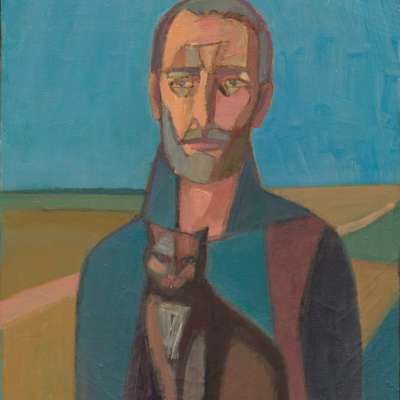Ivanov Mikhail
Mikhail was born in Leningrad in 1944. Fond of drawing since childhood, he attended first the art class at the city Palace of Young Pioneers, and later the celebrated Leningrad Secondary Art School where among his classmates were Mikhail Shemyakin, Oleg Grigoryev, and Gennady Ustyugov. They all, however, were expelled at different times on the grounds of their alleged ‘formalism’ – Mikhail Ivanov first. Then followed three years of study at the Art History Department of the Academy of arts, after which the aspiring artist was drafted for compulsory military service. Stationed not far from Moscow, he travelled there on leave and made friends with the city’s underground artists. Close encounters with Ilya Kabakov, Mikhail Roginsky, and Dmitry Krasnopevtsev had a profound influence on the young painter’s nascent worldview: in the late 1960s, he often visited Moscow and sometimes stayed there for considerable time periods.
Mikhail Ivanov’s memoir mentions 1970 as a significant milestone, the year when he earnestly focused on his painting practice. Prior to that, however, he was seriously into graphic media, and even had his first solo show at the Zvezda magazine editorial office back in 1963, while still a first-year student. Throughout the 1970s, as the artist recalled, he was largely influenced by the works of Malevich, Petrov-Vodkin, and Morandi. No less important was his then recently acquired interest in icon painting. In the mid-1970s, Mikhail Ivanov was closely associated with the Second Russian Avant-Garde, including Vladimir Volkov, Anatoliy Levitin, Pavel Kondratyev, Pavel Basmanov, and Vladimir Sterligov. Around roughly the same time, he gravitated towards the so-called Arefiev circle, becoming a long-time friend of Richard Vasmi, Valentin Gromov, and Vladimir Shagin. The artist also cited as important and instrumental influences the representatives of the Russian Post-Avant-Garde, particularly the landscape paintings of Vera Ermolayeva and Alexander Labas.
The above listing of names of the people of whom Mikhail Ivanov was a friend or a creative associate or by whom he was inspired is not a mere attempt to illustrate his significance, but an important characteristic of a person whose apartment hosted underground art shows and welcomed artists, musicians, and writers for many years.
The broadness of Ivanov’s interests and richness of his artistic background informed to a great extent the distinctive features of his artworks. The artist defined his goal quite simply, claiming he was in search of ‘indicative formulas corresponding to inner experiences and time.’ First and foremost, he was preoccupied with pinpointing universally meaningful imagery and tracing its sources.
Mikhail Ivanov worked with a limited number of subjects, and certain distinctive features make his pictures instantly recognisable. His landscapes and still lifes are pointedly simplified and stylised, inevitably featuring predictably bright green grass and deep blue sky. Interestingly enough, this perceived stylisation was identified by Ivanov himself quite differently. In one of his interviews, he called his art ‘spontaneous self-expression that leaves no room for stylisation but correlates to the symbolic motifs and forms recurrent in a particular culture.’ Ivanov saw the ultimate goal of his artistic practice in finding the archetype that such symbolic motifs and forms could be traced back to, which could only be achieved by freeing the archetype from the countless layers of build-up that used to conceal it. That was exactly what the artist pursued: with remarkable preciseness, he purified the symbolic imagery he used, which found expression in the entirety of artistic devices employed.
One example of Mikhail Ivanov’s interpretation of vanitas, a genre frequently appearing in Baroque art, is his Still Life with Skull and Shell in Landscape acquired for Erarta Museum’s permanent collection in 2008. Here, the choice of objects painted by the artist is symbolic within the constraints of the genre: the human skull alludes to human impermanence, while the shell indicates frailty. The still life is set against the backdrop of a landscape which, in juxtaposition, symbolises immortality.
To Mikhail Ivanov, whose aesthetics demonstrates a wide range influences, the traditions of Modernist, archaic, and classical art were equally valuable and relevant: his thorough and very attentive study of the history of art, a background in icon painting, and his own longstanding experiments shaped his very distinctive and recognisable style which was the ultimate expression of his creative philosophy.
The artist passed away in 2023.






